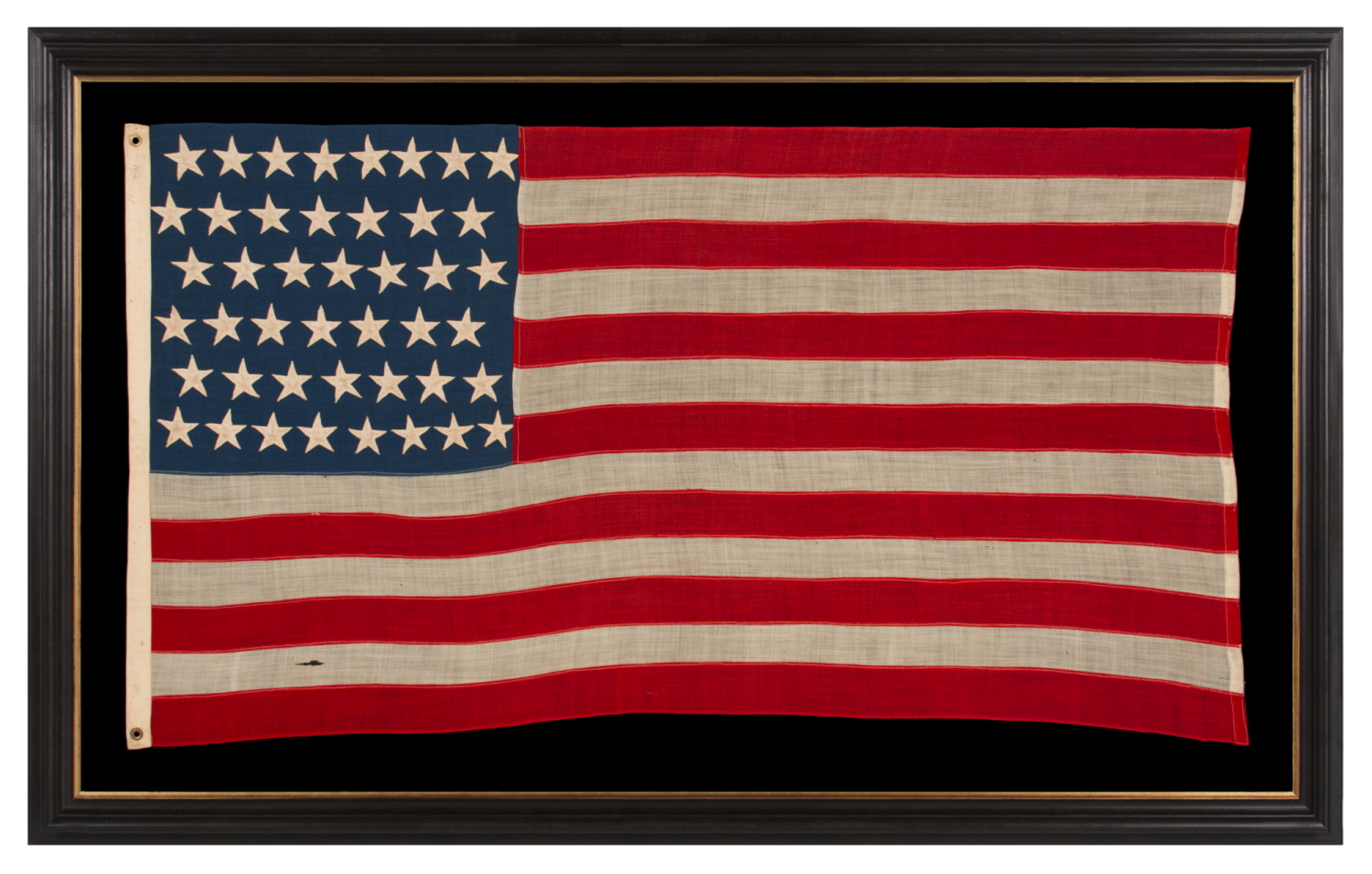


| 44 STARS IN ZIGZAGGING, STAGGERED ROWS, ON ANTIQUE AMERICAN FLAG WITH SOMEWHAT ELONGATED PROPORTIONS AND STRONG COLORS, MADE IN THE ERA WHEN WYOMING WAS THE MOST RECENT STATE TO JOIN THE UNION, 1890-1896 |
|
| Web ID: | 44j-923 |
| Available: | In Stock |
| Frame Size (H x L): | Approx. 54" x 87" |
| Flag Size (H x L): | 42" x 75" |
| Description: | |
| Wyoming was admitted as the 44th state on July 10th, 1890. Although the 44 star count would not become official until July 4th of the following year, flag makers would have begun to add a 44th star immediately, if not even beforehand, in hopeful anticipation. This became common among flag-makers during the latter 19th century, a practice that reflected both their support of westward expansion and a drive not to be out-stepped by their competitors. While the 44 star count remained official until July 3rd, 1896, it would have generally fallen from use at the beginning of that year when Utah was accepted as the 45th state, on January 4th. The stars are configured in zigzagging lineal rows of 8-7-7-7-7-8, a pattern often encountered in this star count. Although these were all oriented with one point directed upward, a lack of uniformity is present in both their profiles and their placement, with some arms bent this way and other almost touching. Both the fabrics and the construction are typical of those produced in a cottage industry setting, by a professional flag-maker of the time. The stars are made of cotton and were double-appliquéd (applied to both sides) with a lineal, treadle stitch. The canton and the striped field are made of wool bunting that has been pieced and joined by treadle stitching. There is a twill-woven binding along the hoist, with two brass grommets, along which “3 ½ x 6” was block-printed in black pigment to denote size in feet. While the scale may seem large to a casual observer, unfamiliar with 19th century examples, it is important to understand that most flags with pieced-and-sewn construction, made prior to 1890, measured 7-8 feet or longer on the fly. At approximately 6 feet 3 inches, this is a small flag among its counterparts of the period. The name “Sheldey” is inscribed along the binding, partially overlapping its maker’s-marked dimensions. This would be the name of a former owner. It was extremely common to mark flags in this fashion, during the 19th and early 20th centuries, to indicate ownership. All-in-all, an attractive example of the period with strong colors and somewhat elongated proportions, in a bold yet easily displayable scale. Mounting: For 25 years we have maintained our own textile conservation department, led by a master’s degree level graduate from one of the nation’s top programs. We take great care in the mounting and preservation of flags and related textiles and have preserved thousands of examples. The flag has been hand-stitched throughout for support flat-lined) to 100% silk organza. It was then hand-stitched to a background of 100% cotton twill, black in color, that has been washed and treated for colorfastness. The black-painted and hand-gilded molding, with its wide, serpentine profile, is Italian. The glazing is U.V. protective acrylic (Plexiglas). Feel free to contact us for more details. Condition: There is minor to modest soiling in the white cotton stars and along the binding. There is a small tear in the last white stripe, near the hoist. There are some extremely tiny holes elsewhere, in limited areas, almost not worth mention. Many of my clients prefer early flags to show their age and history of use. |
|
| Video: | |
| Collector Level: | Intermediate-Level Collectors and Special Gifts |
| Flag Type: | Sewn flag |
| Star Count: | 44 |
| Earliest Date of Origin: | 1890 |
| Latest Date of Origin: | 1896 |
| State/Affiliation: | Wyoming |
| War Association: | 1866-1890 Indian Wars |
| Price: | Please call (717) 676-0545 or (717) 502-1281 |
| E-mail: | info@jeffbridgman.com |
 |
|